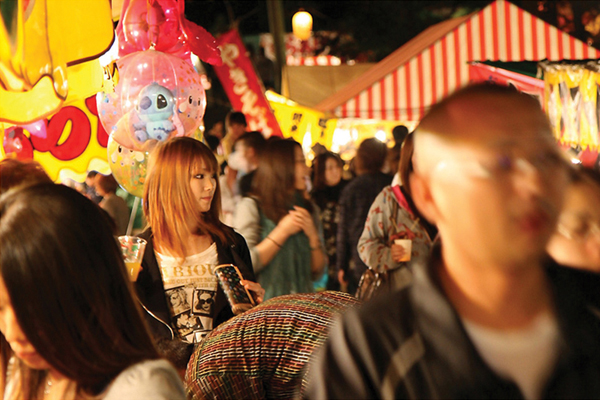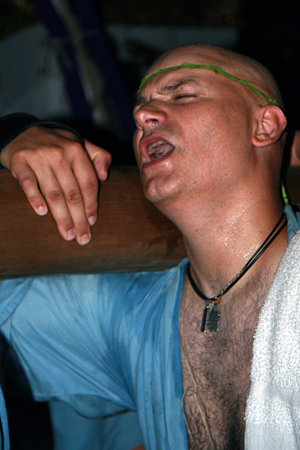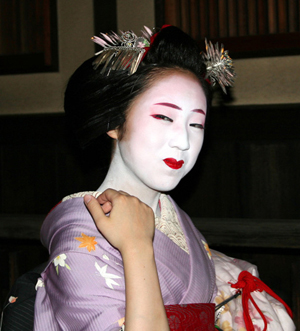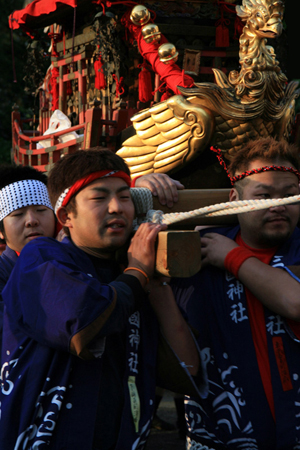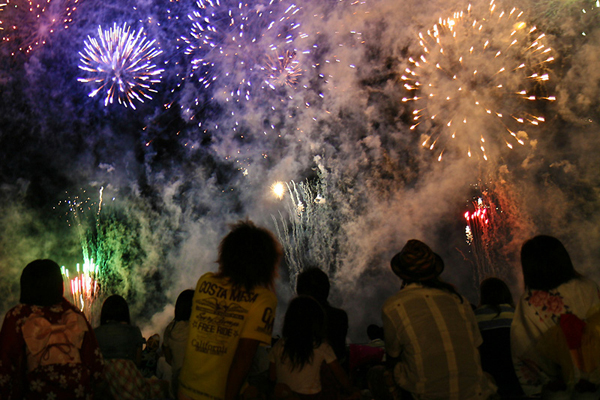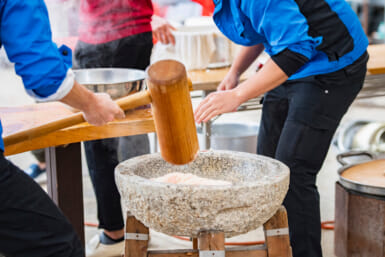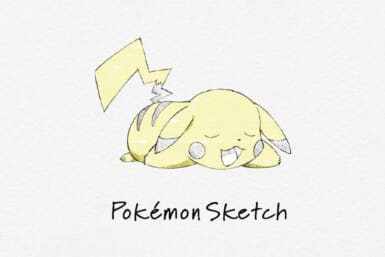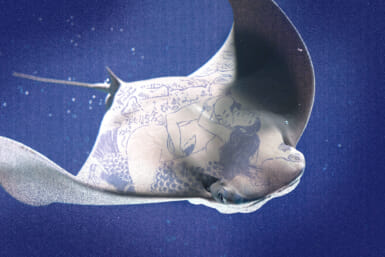It’s time to break out the sandals, endure the humidity and enjoy Japan’s festivals, the matsuri are upon us. Stack Jones has a look at some of his favourites and explores their origins…
Festivals in Japan are incredibly fun. Many of the best ones are in regions of the country that are not so easy to access – off the beaten path, perhaps – but it is worth taking a trip outside Tokyo to visit such events as the Aomori Nebuta Matsuri, the Akita Kanto Matsuri, the Yamagata Hanagasa Matsuri or the Awa-Odori Folk Dance Festival in Tokushima.
The following is a breakdown of some of Japan’s major summer events, as well as little known festivals that are just as much fun, and will surely put a smile on your face during the summer of 2012. If you have the time, I suggest seeing as many festivals as possible, as they are as much fun for the participants as they are for the spectators.
Aomori Nebuta Festival
Dates: August 2nd – 7th
Place: Near Aomori JR train station.
City: Akita City, Akita Prefecture.
This is one event that you don’t want to miss! The Aomori Nebuta Festival is part of a series of star festivals known as Tanabata. On the 7th day of the 7th month of each year, according to Chinese legend, the two stars known as Altair and Vega, which are separated by the Milky Way during the entire year because of their “forbidden love”, are joined together for the evening. Other forms of the story claim that Hikoboshi and Orihime had a great love, yet this love was forbidden. Their curse was that they were to remain separated from each other all of eternity, but their love, being greater than the power to keep it apart, miraculously helps to bring the couple back together on the evening of the Tanabata. Today, both the lore of the story and the fantastic floats and parade make the Nebuta Matsuri one of Japan’s most famous. The event attracts millions of visitors each year.
During this festival, many large floats (nebuta) are paraded through the streets near the Aomori JR train station. These floats are constructed of wood, with metal frames that stand approximately five metres in height and up to nine meters in width. Decorative Japanese paper, washi, is placed and painted onto the frames of the floats. The paper is then decorated with three-dimensional images of warriors, gods and demons that resemble famous kabuki actors. The floats are very intricate and can take up to a year to make. Dances are performed during this matsuri that feature haneto dancers, who wear special costumes – participants are welcome to wear their own haneto costume and join in with the fun.
Akita Kanto Matsuri
Dates: August 3rd – 6th
Place: Kanto O-dori
.
City: Akita City, Akita Prefecture.
Towering high above the spectators and participants are the kanto poles, which light up the night sky. This event is another of the major Tanabata Matsuri taking place in the northern region of Japan. Although in modern times these events draw large crowds of spectators and tourists, the origins were long ago when festive prayers were offered up to the gods in hopes of a rich harvest of wheat, rice, beans, foxtail and millet.
A kanto is a bamboo pole that stands eight meters high, with a number of cross poles attached that have 46 paper lanterns, shaped like rice bales, hanging from them. The tops are decorated with thin shreds of paper, and were originally made to drive away evil spirits and to offer prayers to Shinto and Buddhist deities.
The larger kanto weigh in at 60 kilograms and are called owaka. Smaller versions are known as chuwaka, kowaka and yowaka in descending fashion. All of these Kanto are shaped like Akita cedar or ears of corn. As the festival begins, participants lift up the kanto one at a time to the sound of flutes and drums. The Kanto are then paraded throughout the town while festival participants do their best to ensure that the lights of the lanterns do not go out; with hands never used to support them. The participants prop up the poles with their hips, shoulders or foreheads and shout loudly as they try to outdo the other pole-bearers.
The origins of this festival lie in the Tanabata ritual, from an annual festival held on the evening of July 7th to worship stars, which is called neburi-nagashi. It was believed the stars had the capability to wipe out disease and “malicious energy” that was thought to be the cause of many illnesses. This ritual came to be performed in a grand style around the time of Satake Yoshimasa (1775-1815), who ruled as Lord of the Akita Clan.
Awa-Odori Folk Dance Festival
Dates: August 12th -15th
Place: Throughout the entire city of Tokushima.
City: Tokushima City, Tokushima Prefecture.
Awa is the former name of Tokushima. This festival features folkdances that are performed to welcome the souls of ancestors during the Bon season. This particular festival is well known throughout Japan for the famous words that are associated with the festival, ”Its a fool who dances and a fool who watches. If both are fools, then you might as well have fun dancing.”
The dance originated in 1587, when feudal lord Hachisuka Iemasa (1558-1638), in celebration of the newly-built Tokushima Castle, offered sake to the town folk. The people became so drunk that they started to dance in a strange manner, never before seen. Today, the town’s residents parade through the city while dancing to music performed on drums, gongs, shamisen and flutes. The basic rule of the dance is for the participants to move their right arm and leg forward in unison, and then their left arm and leg.
The dance is performed to a two-beat rhythm that has long been the tradition of the festival. Dances are performed during the day of the event by groups that have been chosen to be the best. However, as the sun begins to set, the entire city is moved in excitement and a high-level of energy that climaxes at around 10:30 p.m. It is at this time that numerous stages, called enbujo, which are scattered throughout the town, allow spectators to observe the Odori Hiroba dance up-close. Spectators are also welcomed to join in on the fun.
Moriya City Yasaka Shrine Festival
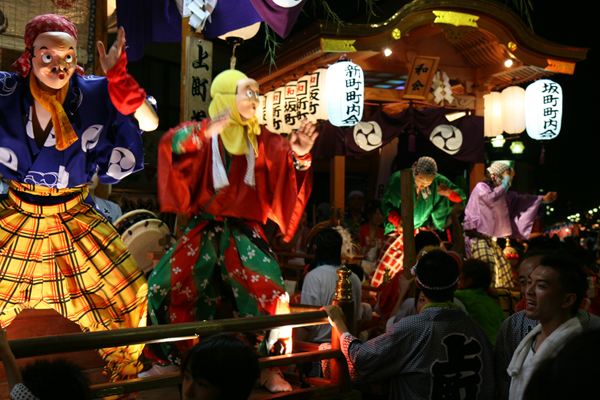
Date: July 28th
Place: Moriya City (Near Aeon Town Shopping Center.)
City: Moriya City, Ibaraki Prefecture.
For those in the Kanto region who don’t have the time to travel to these far reaching locations, there are some great local offerings as well. Some of them are not so well known, but offer a great deal of excitement and entertainment.
The Yasaka Shrine Festival is a summer festival held at the Yasaka Shrine in Moriya City on the last Saturday of July. Legend has it that the people of the area disliked paying taxes to the Emperor, and because complaining vocally meant certain death, the people in the region devised a dance, wore brightly coloured, exaggerated peasant outfits, and masks that expressed the disdain of the people. Those same masks are used today.
During the festival the participants also pray for a rich yield of rice in autumn. A portable shrine is carried through the town and traditional festival music is played on temporary stages, and floats, which are transported around the city. The participants in the event dance on these portable floats, and the highlight of the evening is when all floats are pulled together in the centre of the town, with each one vying to out-perform the others. As the dancers perform, the floats are spun around, making for a lot of great fun and entertainment. The streets are also lined with a variety of food vendors, as many spectators come from all over the country to take part in the event.
Narita Gion Matsuri
Date: July 6th-8th
Place: Naritasan Shinshoji Temple.
City: Narita City, Chiba Prefecture.
The Narita Festival is three days of illuminated light and sound. This event takes place near the Naritasan Shinshoji Temple in the city of Chiba. The event starts with the passage of a portable shrine, and is highlighted by a parade known as Sobiki. During the parade ten floats are adorned with large dolls modeled after historical figures.
Young folk also stand on top of the floats and encourage the bearers to carry them up the steep slope of Nakamachi. This festival is dedicated to Dainichi-Nyorai (Dainichi Buddha). It has become the largest festival in Narita, with millions of visitors each year. The event takes place each day from 10:00 a.m. to 10:00 p.m.
Shimodate Gion Matsuri
Date: July 26th-29th
Place: Shimodate City.
City: Shimodate
City, Ibaraki Prefecture.
Shimodate comes alive with activity for the Gion Festival during the four days that begin on the last Thursday of July. The origins of this festival date back to 1471, when local clan chief Mizunoya Katsuuji encouraged Haguro Shrine to hold an annual festival. Carrying mikoshi (portable shrines) through the city became a key part of the event during the late nineteenth century, and has been the main feature ever since.
The enormous and elaborately decorated Mikoshi are the pride of the festival. The old O-Mikoshi (Large Mikoshi), weighs a ton and was built in 1895; the lighter Hime-Mikoshi (princess Mikoshi) for women, and the new o-Mikoshi, made in 1992 both weigh in at two tons (4000 lbs.), said to be the largest portable shrines in Japan.As the festival begins, the two O-Mikoshi and the Hime-Mikoshi, along with more than thirty children’s Mikoshi, take to the streets. Onlookers are always packed together along both sides of the city’s main road.
The festival reaches its climax in the morning of the final day. At 5:00 a.m. the o-mikoshi are lowered into the water of the nearby river, the Gogyogawa, for a ritual called Kawatogyo, in which the evil spirits and impurities of the world are washed away. They are then carried back to Haguro Shrine, home of Shimodate’s guardian deity. The festival finishes at around 8:00 a.m.
Yamagata Hanagasa Matsuri
Dates: August 5th-7th.
Place: Yamagata City.
City: Yamagata City, Yamagata Prefecture.
The Yamagata Hanagasa Matsuri is a festival where 10,000 of the city’s residents participate in a dance while holding a hanagasa (flower hat) adorned with safflowers. This festival began in 1964 and is therefore relatively new. Don’t let that fool you, though, the festival attracts more than one million spectators and is considered one of the major events in the Tohoku region.
Beautifully decorated floats lead the parade. The shouts of “Yoshi, Mankato!” and the beat of the hanagasa-daiko drums enhance the mood of the festival. The form of the dance has gradually changed over the years; previously, group performances were perfectly synchronized. Today however, the dances are varied, the hanagasa hats playing a key role in the creative performances.
The Hanagasa Festival began as part of the Zao Summer Festival, which was started to promote tourism in Zao, Yamagata. The Hanagasa Dance Song is based on the Dontsuki Song, sung during the Meiji-Taisho Era in the Murayama region of Yamagata Prefecture. The Yassho, Makasho calls were cried out during Dontsuki while pounding on the ground during irrigation work on the outskirts of Obanazawa.
Other notable summer events:
The Sensou-Ji Temple Matsuri is held in Asakusa. July 9th-10th.
The Kangen Sai is held in Hiroshima. August 2nd.
Koenji Awa-odori is held in Koenji, Tokyo on the last Saturday and Sunday of August.
Tsuchiura Fireworks Competition
Date: October 6th
Place: Gakuen Ohashi, Tsuchiura Gakuen Sen
City: Tsuchiura, Ibaraki Prefecture.
Time: 6 p.m. to 8:30 p.m.
Do you like fireworks? Who doesn’t! Japan has a myriad of firework events and as great as many of them are, they all pale in comparison to the Tsuchiura Fireworks Competition. This isn’t just a fireworks show, it’s a full-blown competition where cities and fireworks manufacturers from around the country come together to participate, and show off their skills in blowing stuff up.
Usually held on the first Saturday of October, (postponed if the weather is poor) the Tsuchiura Fireworks Competition is the last major competitive event of the year for pyrotechnic teams from around Japan. Most observers agree that it is best fireworks displays in the entire nation, as fireworks artists put everything they’ve got into the illustrious displays. Many of the bursts are prototypes of new designs for next year’s season, so fireworks manufacturers put great effort in to leaving a lasting impression on potential buyers.
The higher bursts can easily be seen from any elevated spot in Tsukuba with a view of the eastern sky, but it is really worth making the effort to join the crowds near ‘ground zero’ to take it all in. The show begins at about 6 p.m. and lasts for over two hours. Parking is always a problem, and since people begin showing up several hours early to get a good spot, you may have a problem getting to the event if you don’t plan properly.
Be sure to take a plastic tarp to cover the ground along with any other convenience you will need, such as pillows, blankets and mosquito repellant. For those that are not willing to brave the crowds and get in close, the best views are alongside Route 6, which is an elevated highway across the nearby fields.
By Stack Jones

